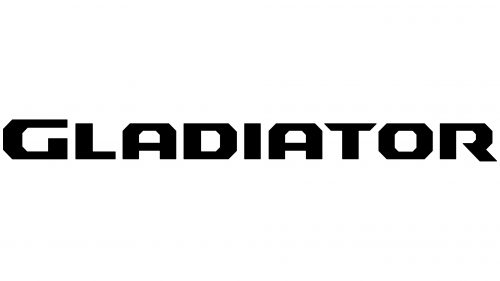The Jeep Gladiator logo resembles a powerful fighter. The emblem connects the vehicle with the image of a brave, strong, and fearless warrior of Roman arenas. The symbol targets a male audience and promises that with this brand’s vehicle, one can embark on the most dangerous journey and emerge victorious.
Jeep Gladiator: Brand overview
The Jeep Gladiator’s story is of renewal and perseverance, mirroring America’s shifting preferences and the brand’s steadfast commitment to its origins. Although many see the Gladiator as a new addition, its roots go back to the heyday of American pickups.
1947, Willys-Overland launched the Jeep Truck, aimed at post-war farmers and craftsmen. It was built on an extended CJ chassis and combined the Jeep’s ruggedness with a practical truck bed. By 1962, the Jeep Gladiator emerged as a more refined successor under Kaiser Jeep’s direction.
Born in an era of chrome and fins, the Gladiator stood out with its functional design. With features like the “Go-Devil” 4WD system and locking differentials, it catered to loggers in Oregon, farmers in Iowa, and oil workers in Texas. The name “Gladiator” was chosen to symbolize strength and resilience.
Throughout the 1960s, the Gladiator earned a reputation for reliability. It wasn’t the fastest or smoothest but thrived in harsh conditions. During Alaska’s devastating 1964 earthquake, Gladiators were among the first to deliver aid to remote areas, cementing its iconic status through word of mouth.
In 1970, American Motors Corporation (AMC) acquired Jeep, rebranding the Gladiator as the J-series as part of a broader strategy to “urbanize” the Jeep lineup. Luxury features like air conditioning and vinyl upholstery were added to attract suburban buyers. Ironically, these “softer” years produced the truck’s most rugged version.
In 1976, AMC collaborated with Trans-Am racer Mark Donohue to create the Jeep Honcho. The Honcho was a forerunner to today’s high-performance off-road trucks with a lifted suspension, wide tires, and an optional Levi’s package with denim seats. Its appearance in the 1984 film “The Terminator” solidified its tough-guy image.
The 1980s were tough. The second oil crisis and the rise of imports hit big truck sales hard. Jeep’s new owner, Chrysler, focused on minivans and compact cars. By 1986, Jeep trucks were discontinued after nearly 40 years of continuous production, seemingly ending the era of Jeep pickups.
Over the next two decades, Jeep fans clamored for a return of the pickup. Chrysler teased concepts like the 2005 Gladiator, but nothing came to fruition. The pickup market was increasingly dominated by larger, more luxurious models, making it seem like the spirit of the original Gladiator was lost.
However, cultural shifts were underway. The “buy local” movement gained momentum, and young professionals turned to crafts and farming. TV shows and social media celebrated “hipster lumberjacks” and “urban farmers.” Suddenly, used Jeep pickups, especially the 1980s Scrambler, became highly sought after, representing a simpler, more authentic American life.
This trend was noticed at Jeep, now part of Fiat Chrysler Automobiles (FCA). In 2017, they unveiled the Jeep Comanche concept at the annual Easter Jeep Safari in Moab, Utah. Unlike flashy show cars, the Comanche was dirty, rugged, and utterly captivating, thrilling the crowds.
Jeep revealed the new Gladiator at the 2018 Los Angeles Auto Show a year later. This was no mere nostalgia trip; FCA had meticulously studied what made the original Gladiator special—its versatility, durability, and Jeep heritage—and reimagined it for modern times.
The new Gladiator, which was launched as a 2020 model, was built on an extended Wrangler chassis. It retained signature features like a fold-down windshield, removable doors, and roof. Yet, beneath its vintage look lay modern technology: surround-view cameras, adaptive cruise control, and a Wi-Fi hotspot.
Importantly, the Gladiator was designed as a tool. Its bed was steel, unlike many competitors’ plastic beds. The Max Tow package could haul up to 7,650 pounds—enough for a vintage Airstream or a racing Jeep. Jeep offered many dealer and aftermarket accessories, from pull-out kitchen modules to rooftop tents.
When the Gladiator hit the market, it resonated unexpectedly. The COVID-19 pandemic has shaken the world, prompting many to rethink their lifestyles. Remote work became the norm, and cities emptied. The Gladiator represented an escape and a redefinition—a chance to build a self-sufficient, nature-connected life.
Dealers reported customers using their Gladiators in diverse ways: architects transporting materials to remote sites, brewers delivering kegs to farmers’ markets, and musicians touring small towns with their gear. In an era when many pickups never see dirt, the Gladiator reminded people of the original purpose of these vehicles.
By 2023, the Gladiator lineup had expanded. The High Altitude offered premium luxury, while the Mojave, with its FOX racing suspension, was built for Baja-style dune jumping. Yet, the most symbolic model was the Willys Sport—a simple trim that harkened to the original 1947 Jeep Truck.
In 2024, a significant milestone was marked: announcing the all-electric Gladiator EV. Skeptics questioned whether such a traditional vehicle could transition to electric power. Early reviews were promising, though. With the instant torque of electric motors and the low center of gravity from the batteries, the electric Gladiator proved even more capable off-road. Moreover, its battery could power tools, making it the perfect mobile workshop or field research station.
Meaning and History
2018 – today
The Jeep Gladiator logo features a minimalist and restrained style, highlighting the essence and spirit of one of the company’s most iconic vehicles. The simplicity and clarity of the logo design reflect the strength and power associated with this off-road vehicle.
The name “Gladiator” was chosen for the JT model produced in Mexico. This name refers to the fighters of Roman arenas, symbolizing the car’s bold and indomitable spirit. The angular letters of the logo resemble armor, adding an extra layer of strength and protection, matching the characteristics of the Jeep Gladiator.
The emblem combines historical associations with modern design, successfully merging past and present. It reflects the brand’s heritage and innovation. The logo’s color scheme is black, giving it a solid and rugged look.





